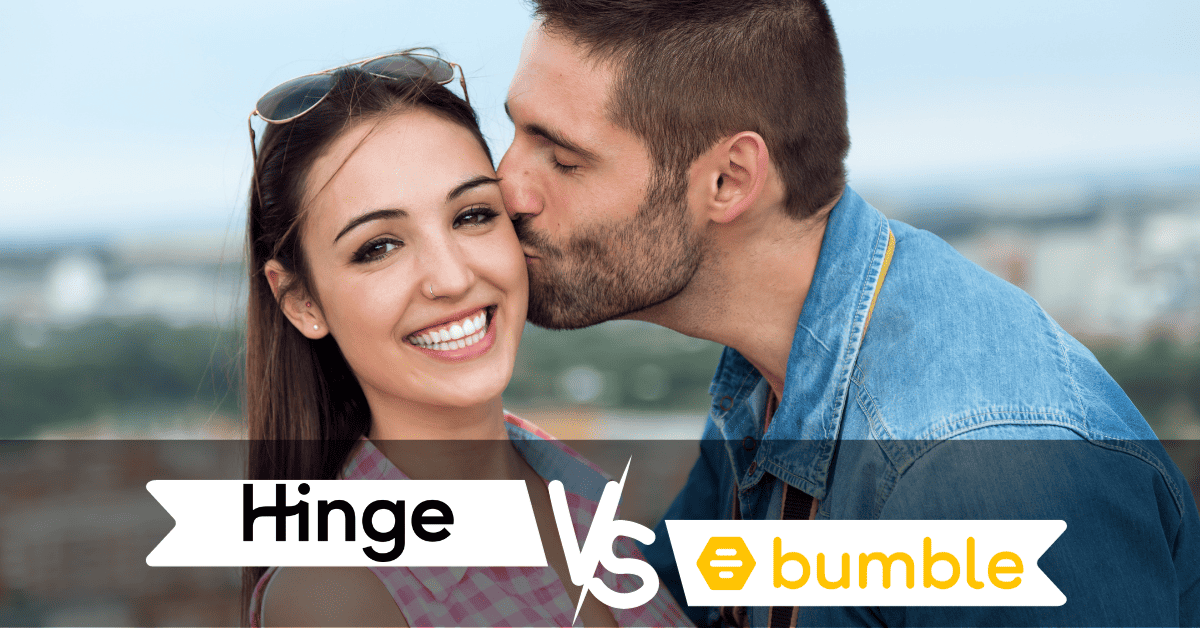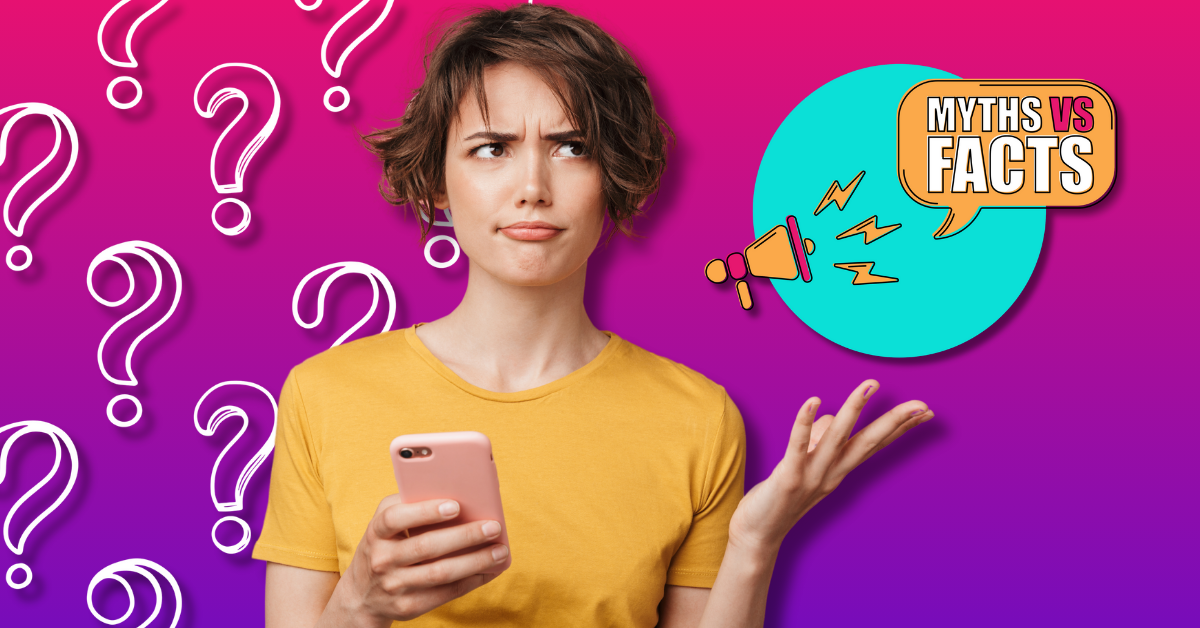So many dating platforms call out to singles like a siren’s song promising real romantic connections, and two superstars in this arena are Hinge and Bumble, each utilizing unique outlooks and tools that assure a fresh approach to online dating. Both have gained significant traction in the last few years, but they branch off in their styles and user experiences, making them interesting apps to compare.
Hinge, dubbed “the dating app designed to be deleted,” focuses its dating community on creating lasting relationships. Unlike its competitors, Hinge encourages members to share more comprehensive profiles, adding prompts and questions that go beyond surface-level introductions. It’s this emphasis on real rapport and compatibility that differentiates Hinge, hoping to transition couples from online chats to real-life commitments.
Bumble, meanwhile, swaps traditional (or patriarchal, if you will) dating dynamics by empowering women to make the first move. When a mutual match occurs, women are given 24 hours to strike up a conversation, a feature that aims to create a more respectful and balanced interaction habitat. And they go even further than just dating—Bumble has diversified into avenues of friendship and business with “Bumble BFF” and “Bumble Bizz,” respectively, showing off its broader inspiration for human connection. As we examine each app, we’ll compare the distinctions and highlights of each platform so we can help you choose which one is best for you and your dating/relationship goals!
Side to Side Comparison
Hinge and Bumble both offer a nuanced approach to connection and companionship—while both platforms cater to singles negotiating the challenges of modern romance, they diverge with distinct features and outlooks. So, how do they measure up when placed side-by-side?
| Hinge | Bumble | |
|---|---|---|
Philosophy | Marketed as “the dating app designed to be deleted,” Hinge’s goal is to foster deep connections that lead to meaningful, offline relationships. | Bumble is the first dating platform to shift traditional dating power dynamics by letting women steer the interactions and initiate conversations, which contributes to a more balanced dating playing field. |
Profile Depth | Comprehensive profiles with prompts and questions encouraging users to showcase their personalities and preferences. | Bumble profiles combine photos with shorter bios and a few optional prompts or icebreakers, making things short and sweet without sacrificing details. |
Interaction | Users can “like” specific parts of another’s profile, be it a photo or an answer to a prompt, leading to more personalized conversation starters. | With a mutual match, women have 24 hours to start a conversation, after which the match disappears. |
Demographics | Often appeals to those looking for more serious relationships or lasting connections. | Attracts a diverse range of users, from those looking to date casually as well as those hoping to find long-term partnerships. |
Unique Features | The app regularly checks in on matched pairs, asking if users went on a date and how it went, which helps it improve its matchmaking algorithm. | Bumble also offers “Bumble BFF” for friendships and “Bumble Bizz” for professional networking, promoting social connections as well as dating. |
While both Hinge and Bumble have carved their niches in the online dating market, the choice between them ultimately hinges (yes, that pun is very intended) on individual preferences.
User Demographics
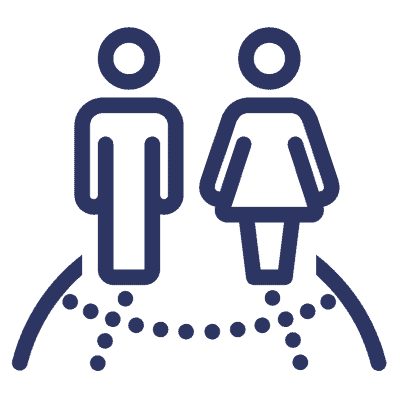
While it’s hard to pin down exact demos for dating apps since they tend to change from day to day, here’s a general overview of the user demographics for Hinge and Bumble.
- Hinge:
- Age Range: Hinge users tend to fall primarily in the 24-35 age range, but it’s used by people of all ages.
- Intent: Hinge markets itself as a platform for people looking for more serious relationships, which can attract individuals interested in longer-term commitments.
- Geography: Initially, Hinge was more popular in urban areas, but its reach has expanded over time.
- User Base: With its tagline “Designed to be deleted,” Hinge tends to attract users who are more intentional about dating and finding a relationship.
- Bumble:
- Age Range: Bumble’s core user base also tends to be young adults, particularly those in their mid-20s to early 30s. However, like Hinge, it has a broad age range of users.
- Intent: Bumble began as a dating platform but has expanded its services to include Bumble BFF (for friendships) and Bumble Bizz (for professional networking). This branching out can (and does) attract a wider range of users.
- Geography: Bumble has a global presence and is popular in both urban and suburban areas.
- User Base: Given its women-first messaging feature for matches, Bumble is known for empowering women and attracting a user base that appreciates this dynamic.
User Interface and Experience

Now, let’s take a look at each dating app’s UI and experience!
- Hinge:
- Profile Layout: Hinge profiles are designed to give a deeper insight into a person’s character and interests. Users answer prompts, which are interspersed with photos, making the profile feel more like a narrative.
- Interactions: Rather than swiping left or right, users on Hinge can “like” a specific part of someone’s profile, whether it’s a photo or an answer to a prompt. This allows for more personalized interaction and conversation starters.
- Feedback Loop: Hinge frequently asks about users’ experiences with their matches to improve its suggestions in the future.
- Design Aesthetics: Hinge adopts a clean, muted color palette with a user-friendly layout. It feels slightly more mature and less game-like compared to some other dating apps.
- Bumble:
- Profile Layout: Bumble profiles combine photos with shorter bios. Users can also answer some prompts, but the emphasis is more on visual appeal.
- Interactions: Bumble uses the swipe left (no thanks) and swipe right (yes, please) mechanism. In heterosexual matches, women have 24 hours to initiate a conversation after a match, or the match disappears. This creates a sense of “hurry up” and encourages quick engagement.
- Multiple Modes: Bumble offers three modes—Bumble Date, Bumble BFF, and Bumble Bizz. Users can toggle between these modes depending on whether they’re looking for romantic, platonic, or professional connections.
- Design Aesthetics: Bumble has a bright and engaging design characterized by its signature yellow color. The interface feels modern and intuitive.
Both apps strive for a user-centric design, focusing on simplicity and ease of use. Hinge aims to foster deeper, meaningful interactions, and Bumble, while also used for finding serious relationships, offers a little more versatility in terms of the kind of relationships users might be looking for.
Features
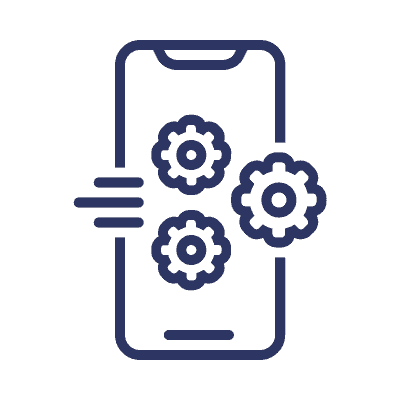
Both Hinge and Bumble offer a lot of fun and innovative features to enhance the user experience. Here’s a comparison of the features each app provides.
- Hinge:
- Prompt Answers: Users answer various prompts to showcase their personality, interests, and sense of humor.
- Likes and Comments: Instead of simple swipes, users can “like” a specific section of someone’s profile and even leave a comment, leading to more targeted interactions.
- Rose: A premium feature where users get a limited number of roses each week to show extra interest in someone.
- Who Liked Me: Allows users to see everyone who has “liked” them, accessible via premium membership.
- Premium Membership: A paid tier that offers additional features such as unlimited likes, advanced preferences, and the ability to see who liked your profile at once.
- We Met Feature: After users exchange phone numbers, Hinge asks how the date went, helping the app gather feedback and improve matchmaking.
- Video Calls: Introduced as an in-app video dating feature allowing users to have video chats with their matches.
- Bumble:
- Women First Messaging: In heterosexual matches, women have 24 hours to initiate a conversation, emphasizing a safer environment and shifting traditional power dynamics.
- Bumble BFF: A mode for users looking to make platonic friendships.
- Bumble Bizz: A professional networking mode allowing users to expand their professional circles.
- SuperSwipe: A premium feature that lets users show heightened interest in someone.
- Bumble Boost: A paid tier offering features like seeing everyone who swiped right on you, extending matches by 24 hours, and rematching with expired connections.
- Bumble Premium: An even more advanced paid subscription with additional benefits such as unlimited swipes, access to the Beeline (seeing who liked you), and travel mode.
- Video and Voice Calls: Bumble offers voice and video call options, allowing matched users to communicate without exchanging personal numbers.
Pricing
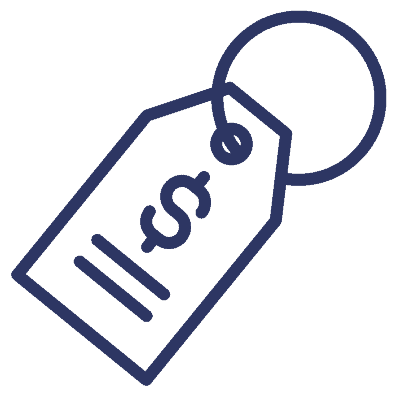
Here’s a breakdown of the pricing structures for Hinge and Bumble:
- Hinge:
- Free Version: Allows users to send up to 10 likes per day, view a limited number of profiles, and engage in conversations with matches.
- Premium Membership: Unlimited likes. Advanced filters for preferences. An option to see everyone who liked you at once.
- Prices: $34.99/month for one month, $64.99/month for three months, or $99.99/month for six months.
- Hinge:
- Free Version: Provides the basic swipe, match, and chat functionality, with women initiating conversations in heterosexual matches.
- Bumble Premium: Unlimited swipes. Access to the Beeline (to see who liked you instantly). The ability to see users who have swiped right on you. The option to extend one match daily for 24 hours. Rematching with expired connections. Advanced filters for more refined matching. Travel mode to set your location to another city.
- Prices: $19.99/week, $39.99/month, $76.99 for three months, $119.99 for six months, or a one-time payment of $229.99 for a lifetime subscription.

Background and History: Hinge vs Bumble
When it comes to love and connection, Hinge and Bumble have forged their own paths, recognizing the cultural changes to adapt to what it’s like to date in this day and age.
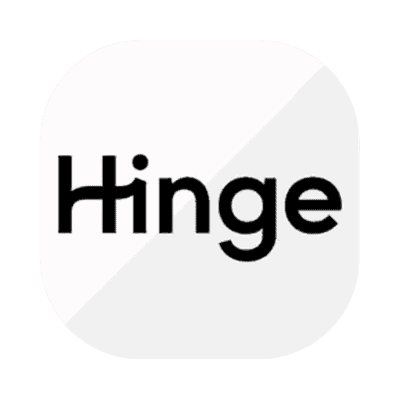
Hinge
- Founded: Hinge was created by Justin McLeod and launched in 2012.
- Initial Concept: Originally, Hinge used Facebook connections to introduce users to friends of friends, positioning itself as a less random alternative to other dating apps. Users were matched based on shared Facebook connections, interests, and mutual friends.
- Evolution: In 2016, Hinge underwent a significant rebranding. It no longer required users to log in via Facebook, and it shifted its focus to helping users find more serious, long-term relationships. The redesign incorporated more detailed profiles with the addition of prompts to foster deeper conversations and connections.
- Slogan Change: With the rebrand, Hinge adopted the tagline “the dating app designed to be deleted,” emphasizing its goal to get users off the app and into committed relationships.

Bumble
- Founded: Bumble was launched in December 2014 by Whitney Wolfe Herd, who was also a co-founder of Tinder—she wanted to develop a more women-centric dating platform.
- Unique Selling Proposition: From the outset, Bumble set itself apart by allowing only women to initiate conversations in heterosexual matches, aiming to shift old-school dating dynamics and create a safer, more empowering place for women.
- Expansion: Over the years, Bumble expanded its platform beyond dating with the introduction of Bumble BFF (for making friends) and Bumble Bizz (for professional networking) in 2016 and 2017, respectively.
- Public Offering: Bumble went public in February 2021, solidifying its status as a major player in the online dating industry.
- Advocacy: Beyond its app, Bumble has engaged in various initiatives to support women, from funding female entrepreneurs to advocating for legislation against online harassment.
Both Hinge and Bumble have experienced shifts in their models and features since their inception. While Hinge has honed its focus on deeper connections and meaningful relationships, Bumble has broadened its scope to encompass various forms of social networking, all while prioritizing female empowerment.
Free Trial Comparisons: Hinge vs Bumble
The free trials in dating apps lie in offering potential subscribers a sip (not a big gulp, as they want you to upgrade to a premium membership) of the full experience. Regarding the free trial offerings and the basic features of Hinge and Bumble, the following is what users can expect!

Hinge Free Trial
- Basic Free Version: Send up to 10 likes per day. View profiles and engage in conversations with matches. Use some of the basic filters for matching.

Bumble Free Trial
- Basic Free Version: Basic swipe, match, and chat functionality. Women have the initiative to start conversations in heterosexual matches. Users can still use Bumble BFF and Bumble Bizz in this free version.
- Free Trial for Bumble Boost/Premium: Similar to Hinge, Bumble occasionally runs promotions where they offer a limited-time free trial for their Bumble Boost or Bumble Premium services. The specifics, such as the duration and what features are included in the trial, can vary.
Success Rates: Hinge vs Bumble
Success rates for dating apps can be a bit hard to nail down due to several things: The definition of “success” can vary from one individual to another, the methods by which companies measure success can differ, and not all companies release detailed statistics on their success rates. However, here’s what we know about the perceived success rates of Hinge and Bumble.

Hinge
- Tagline Promise: Hinge brands itself with the tagline, “Designed to be deleted,” suggesting its goal is to help users find lasting relationships rather than endless swiping.
- Claims: Hinge has claimed that users are eight times more likely to go on a date through their platform than with other apps. Furthermore, they’ve stated that three out of four first dates on Hinge lead to second dates.
- Studies & Testimonials: While Hinge frequently shares success stories and testimonials from users who found lasting relationships through the app, quantifiable success rates for long-term relationships or marriages are not easily found.

Bumble
- Empowerment Focus: Bumble’s unique selling point is its women-first approach, where women initiate the conversation in heterosexual matches. This approach aims to foster more respectful and meaningful conversations, which could lead to more successful connections.
- Growth Metrics: Bumble often highlights its rapid user growth and high engagement rates as indicators of its success.
- Studies & Testimonials: Like Hinge, Bumble showcases success stories from users who’ve found relationships on the platform.
It’s important to approach these claims with a dose of healthy skepticism—while lots of people have found lasting relationships on the platforms, user experiences can vary wildly. Additionally, “success” on a dating app could mean a meaningful short-term relationship, a long-term commitment, a marriage, or even a fulfilling friendship (in the case of Bumble BFF). The best way to gauge the potential for success is to try the apps and see how they work for you!
Signing Up: Hinge vs Bumble
Both apps have optimized their sign-up processes to be user-friendly and quick, ensuring users can start browsing and matching without much hassle. Here’s a quick breakdown of the sign-up procedures for Hinge and Bumble!

Hinge
- Download the App: You can find the Hinge app in the App Store or Google Play Store.
- Phone Number or Facebook: You can choose to sign up using your mobile number or connect
- Profile Creation: Once registered, you’ll be prompted to fill out your profile. This includes uploading photos, answering prompts, and setting preferences for potential matches (like age range, distance, etc.).
- Browsing & Matching: After setting up, you can browse profiles and send likes or comments.

Bumble
- Download the App: Bumble is available in the App Store or Google Play Store.
- Phone Number or Facebook: Like Hinge, Bumble allows sign-up via mobile number or Facebook.
- Profile Set-Up: You’ll be guided to set up your profile, which involves adding photos, writing a bio, and setting your match preferences.
- Mode Selection: Bumble has three modes–Date, BFF, and Bizz. Choose which one you’re interested in (you can switch modes anytime).
- Verification: Bumble has a photo verification process to combat fake profiles.
- Start Swiping: Once set up, you can begin swiping and making connections.
For both apps, set aside some time to complete your profile thoroughly–comprehensive dating profiles with good photos and thoughtful answers can really enhance your chances of making real connections.
Dedicated Mobile Apps: Hinge vs Bumble
Hinge and Bumble each have dedicated mobile apps designed for an optimized mobile user experience. Keep reading for a quick overview of both mobile apps.

Hinge
- Platform Availability: Hinge is available for both iOS (Apple devices) and Android.
- Design Philosophy: Hinge’s app has a clean and user-friendly interface. The layout promotes depth, encouraging users to engage more deeply with profiles by showcasing photos alongside answers to conversation prompts.
- Features: The mobile app encompasses all the primary features of Hinge, including liking and commenting on specific sections of profiles, setting match preferences, and viewing potential matches in a card-like format.
- Notifications: Users can receive real-time notifications for likes, comments, and messages to stay engaged.

Bumble
- Platform Availability: Bumble is also available on both iOS and Android platforms.
- Design Philosophy: Bumble’s app features a bright, modern design dominated by its signature yellow color. It’s intuitive and encourages users to swipe left or right on profiles.
- Features: Bumble’s mobile app allows users to switch between its three modes: Date, BFF, and Bizz. It incorporates all main features, such as swiping, messaging, and video/voice calling within matches.
- Notifications: Bumble users can get real-time alerts for matches, messages, and other in-app activities.
Hinge and Bumble are regularly updated to fix bugs, introduce new features, or enhance the overall user experience. They are free to download, with in-app purchases or subscriptions available for premium features.
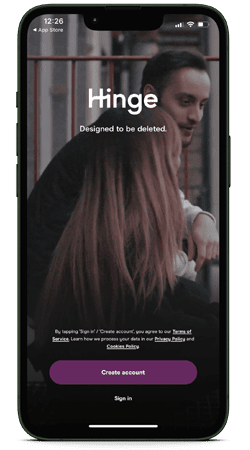
What’s Hinge Best For?
Hinge positions itself as a dating app designed for individuals looking for more serious, meaningful relationships rather than casual encounters. Here are some aspects that Hinge emphasizes to cater to users seeking longer-term connections:
- “Designed to be Deleted”: Hinge’s marketing tagline is “The dating app designed to be deleted.” This slogan underscores their aim to help users find a lasting partnership and then delete the app because they no longer need it.
- Depth Over Quantity: Unlike some apps that encourage endless swiping, Hinge focuses on fostering deeper interactions. This is facilitated through profile prompts and the ability to like or comment on specific parts of someone’s profile.
- Profile Prompts: Hinge profiles include answers to personal questions and prompts. These prompts help showcase a user’s personality, preferences, and humor, offering more insight than just photos.
- Feedback on Dates: The “We Met” feature allows users to give feedback on how their dates went with matches. This not only aids Hinge in improving its matching algorithm but also emphasizes the platform’s focus on real-life dates and relationships.
- No Swiping: Instead of the traditional swipe mechanism, Hinge allows users to scroll through profiles, which encourages spending more time viewing and reading about potential matches.
- Limited Likes: In the free version, users have a limited number of likes they can send daily, which encourages more thoughtful selections rather than mindless swiping.
Given these features and its positioning, Hinge is best for individuals looking for deeper connections, meaningful conversations, and more committed relationships.
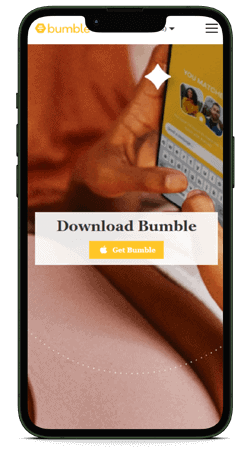
What’s Bumble Best For?
Bumble hit the online dating scene and stepped up the game as a swipe-based dating app, but it boasts a wider appeal and is recognized for various dating and social experiences. Here’s what Bumble is best known for!
- Casual Dating & Relationships: While there’s a fair share of people finding long-term commitments on Bumble, it also facilitates casual dating and relationships, particularly among the younger demographic.
- Global Reach & Travel: With a substantial user base, Bumble is handy for individuals on the move or relocating to new cities. Features like the Travel mode allow users to connect with people from different locales.
- Quick Matches: The swipe feature enables users to swiftly browse through profiles, catering to those who appreciate a rapid matching experience.
- Diverse User Base: Owing to its widespread acclaim, Bumble hosts a diverse user base, making it an apt platform for individuals of varying ages, interests, and backgrounds.
- Social & Networking Opportunities: Bumble extends beyond dating with features like Bumble BFF and Bumble Bizz, catering to those looking to enlarge their social circles or forge professional connections.
- LGBTQIA+ Friendly: Bumble provides multiple gender options and has implemented features to foster a more inclusive and friendly environment for the LGBTQIA+ community.
- Ease of Use: The straightforward swipe mechanism and minimalist design render Bumble user-friendly, especially for those new to online dating.
Bumble is super versatile, addressing a host of romantic goals, from casual encounters to serious relationships. Nonetheless, due to its design and ethos, it’s particularly angled towards a more balanced dating experience, encouraging a respectful interaction by allowing women to always make the first move.
Takeaways
While Bumble thrives on its broad appeal and a range of romantic relationship choices, including platonic and professional ones, making it perfect for a diverse range of interactions, Hinge leans into fostering deeper connections with its intricate profile setups and focus on genuine conversations.
Bumble lets women make the first move, which can make it a safer place for them—it’s good for both casual chats and looking for a serious relationship.
Hinge, with its motto “Designed to be Deleted,” is geared more toward helping people find serious relationships. It encourages users to take time viewing profiles, unlike the quick swipes on Bumble. So, if you’re looking for something more serious, Hinge might be the better choice, while Bumble is good for a mix of fun and serious dating.
Bumble also has a few more features compared to Hinge; besides dating, you can connect with platonic friends or even business connections with its Bumble BFF and Bumble Bizz companion apps. Hinge sticks to dating and doesn’t venture into these other areas, making Bumble more versatile if you’re looking to meet different types of people, not just romantically.
Your choice between Hinge and Bumble really depends on what you’re looking for! If you want to date, meet new friends or network, Bumble gives you all of these options. If you’re more interested in finding a serious relationship, Hinge is built just for that.
Both apps offer unique experiences catering to varied relationship goals. The right fit hinges (pun intended again) on a person’s ideal kind of connection and dating goals!
Want to see more dating app options? Check out our list of recommended dating apps!
